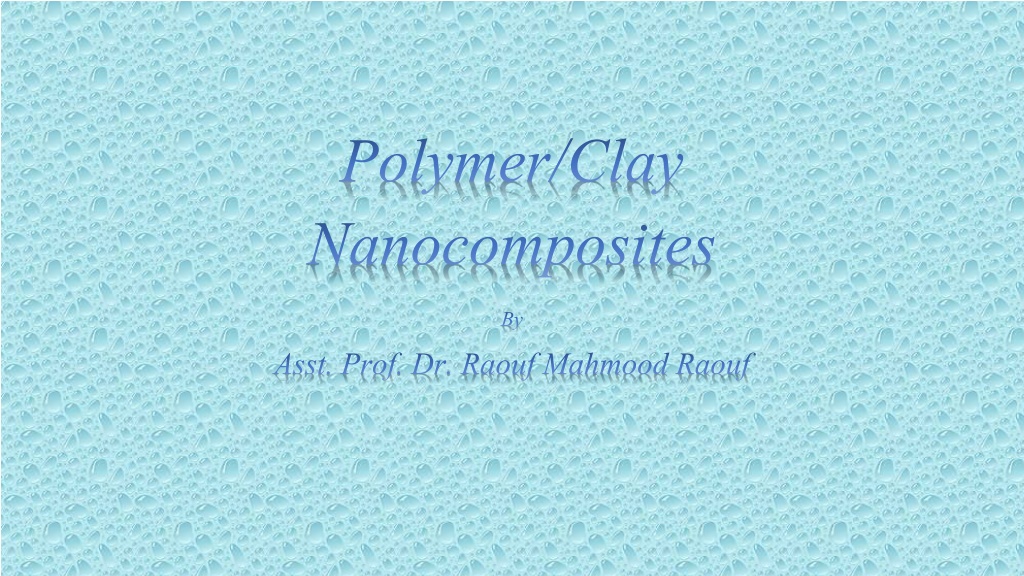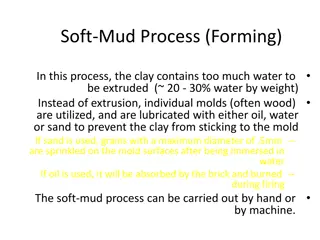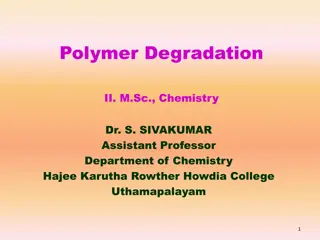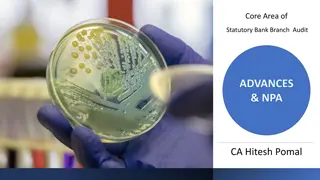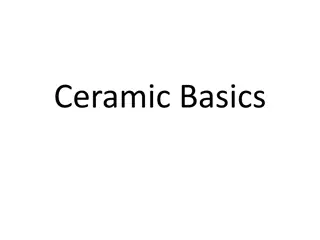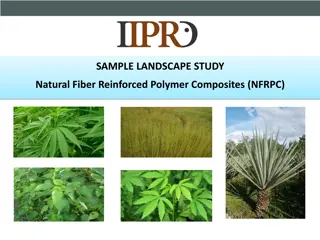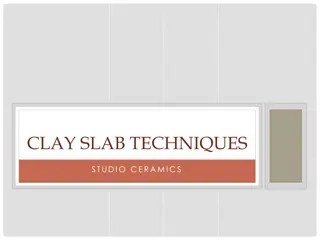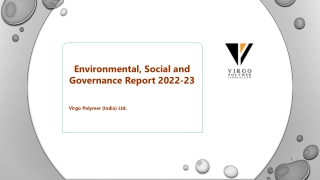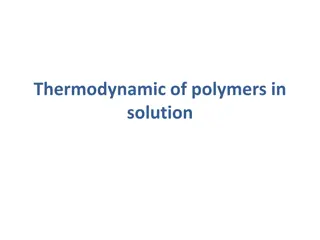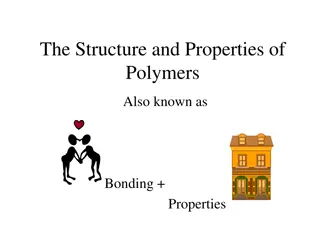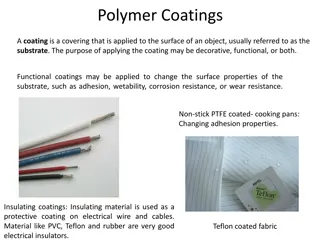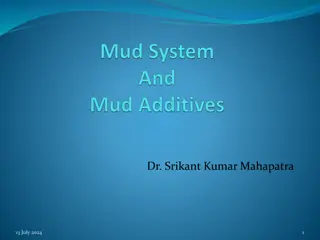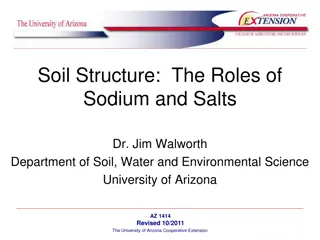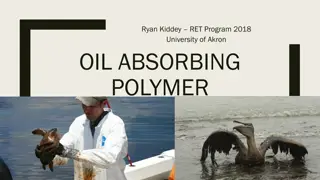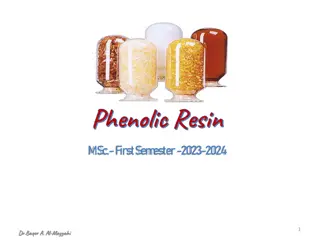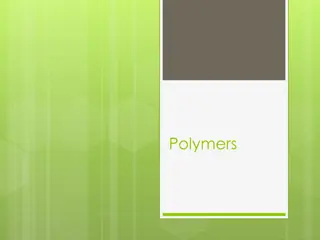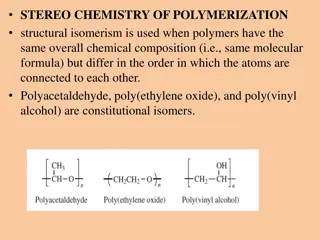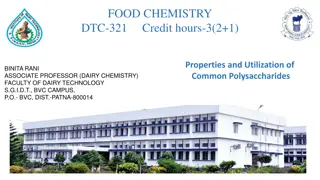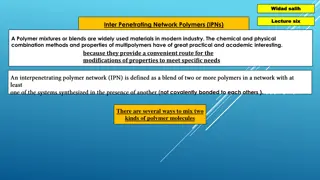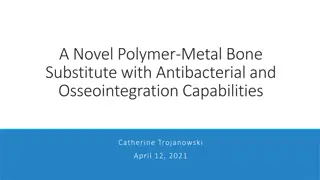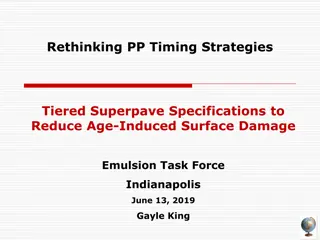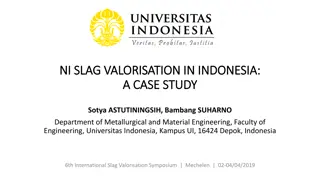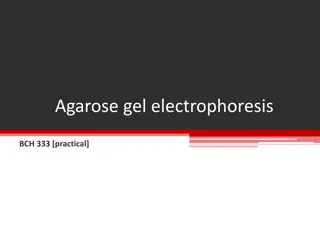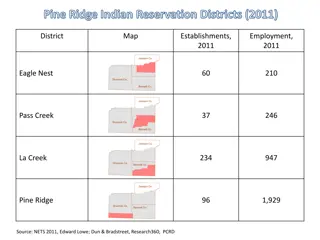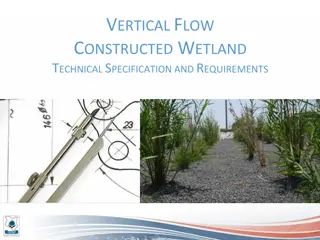Advances in Polymer/Clay Nanocomposites
Clay, particularly montmorillonite, is being increasingly utilized as a reinforcing agent in polymer nanocomposites. By modifying the clay's surface with organic onium ions, the compatibility between clay and polymer is enhanced, leading to improved mechanical and thermal properties in the resulting nanocomposites. The intercalated or exfoliated structures of these materials show significant enhancements in tensile strength, modulus, flexural strength, and thermal stability. The synthesis of Nylon-6/clay nanocomposites has shown remarkable performance improvements, demonstrating the potential of these materials in various applications.
Uploaded on Sep 21, 2024 | 0 Views
Download Presentation

Please find below an Image/Link to download the presentation.
The content on the website is provided AS IS for your information and personal use only. It may not be sold, licensed, or shared on other websites without obtaining consent from the author. Download presentation by click this link. If you encounter any issues during the download, it is possible that the publisher has removed the file from their server.
E N D
Presentation Transcript
Polymer/Clay Nanocomposites By Asst. Prof. Dr. Raouf Mahmood Raouf
Introduction Clay, a natural source, with small loadings (%by weight) can substitute reinforces which are being used in polymers. The commercial importance of polymers has led to an strong investigation of polymeric material nanocomposites, of sizes varying from 1 to 100nm. These are being reinforced by particulates, fibers and layer inorganic fillers. In specific, in the case of layer inorganic fillers, taIc and mica are of maximum interest. There have been also recent advances in polymer/clay and polymer-layered silicate nanocomposite materials in recent times.
Introduction Clay, in particular montmorillonite (MMT), a 2: 1 phyllosilicate as illustrated in Figure A, naturally occurs as stacks of platelets as in talc and mica but possesses different layer charge. This leads to isomorphic substitution within layers and generates a negative charge exchange capacity (CEC) and for MMT.
Introduction The replacement of inorganic exchange cations with organic onium ions on the gallery surfaces of clays not only serves to match the clay surface polarity with the polarity of the polymer, but it also expands the clay galleries. Each platelet is less than l0A thick, but over 200 times more in width. The gallery spacing separates each platelet. These spaces in MMT can be enhanced to 2-3nm using quaternary ammonium salts.
Introduction This enables the penetration of the gallery space by intercalation or exfoliation(the complete separation of the layers of the material) of either the polymer precursor or preformed polymer. If the extended chains are inserted in the self-assembled, well ordered gallery spaces, it is termed as intercalated structure as illustrated in Figure B. If the individual silicate layers are no longer close enough to interact with adjacent layers it is termed as delaminated or exfoliated structure as explained in Figure C. Both of these hybrid structures can exist. The enhancement in properties of polymer with modified MMT is mainly due to the clay which swells extremely in water and which in turn creates large surface area in which the polymer resides.
Polymerization of caprolactum Polymerization of caprolactum, along with modified MMT, resulted in the first synthesis is of an exfoliated Nylon-6 polymer/clay nanocomposite.With just 5%(by weight) loading of clay. They reported 40% higher tensile strength, 68% higher tensile modulus, 60% higher flexural strength, 126% higher flexural modulus and increase of heat distortion temperature from 65 C to 152 C. This nanocomposite is being used commercially in making tough, heat resistant, nylon timing belt covers.
polymer/clay nanocomposites Since then large number of new polymer/clay nanocomposites have been developed like polyurethane, PVC, polyesters, polystyrene and polypropylene. The hydrophobicity /hydrophilicity of the polymer affects its dispersion in the clay layers leading to the exfoliated or intercalated structure. Different methods using OMMT (organically modified clay by surfactants) have been used to overcome this problem. The method of preparation of these polymer/clay nanocomposites has to consider the extent of intercalation/exfoliation which determines the properties of the new-formed materials.
polymer/clay nanocomposites Many methods have been planned to prepare polymer/clay nanocomposites. In general, these methods achieve molecular level incorporation of the layered silicate (e.g. MMT clay, or synthetic layered silicate) into the polymer by addition of a modified silicate during the polymerization (in situ polymerization). Several other methods like sonication, adsorption via sonication, extrusion and spin casting techniques have been also reported as better methods to prepare polymer/clay nanocomposites.
polymer/clay nanocomposites Even hyper branched polymer/clay nanocomposites have been synthesized and exhibit enhancement in their properties. Rheological properties of nanostructured polymer/clay nanocomposites are strongly influenced by the morphology of the materials, which depends on the clay dispersion in the polymer matrix.
Characterization Methods Several methods like SAXS, XRD, TEM, TGA/DTA to mention a few, determine the extent of the hybrid structure that is formed. Among them is X-ray diffraction technique (XRD), which determines the d spacing in the modified clay and provides information on the degree of hybrid structure generated. Diffraction peaks in the low angle region (SAXS) indicate the d-spacing (basal spacing) of ordered intercalated and ordered delaminated nanocomposites: disordered nanocomposites show no peak in this region due to the loss of structural registry of the layers and (or) the large d-spacing (> 10 nm). This can further be verified using the TEM analysis. TGA/DT A analysis is performed to ascertain the thermal stability.
References [I] EP GialUlelis, It Krishnamoorti and E Manias, Polymer-Silicate Nanocomposites. Model Systems for Confided Polymers and Polymer brushes,Advances in Polymer Science, Vol.138, pp.107-148, 1998. [2] TJ Pinnavaia and GW Beall, Polymer-clay nanocomposites, John Wiley and Sons, 2001.
